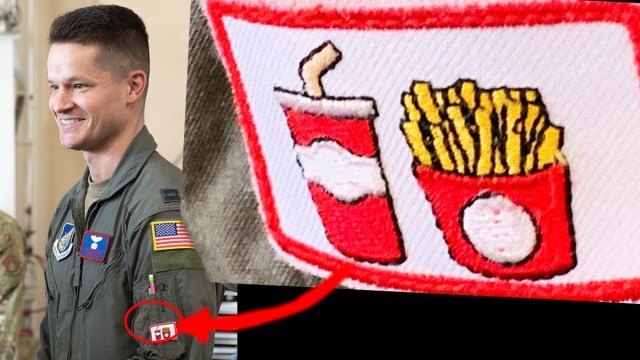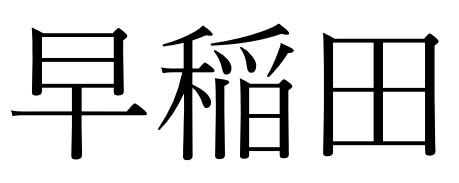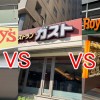
Special technique to help newcomers acclimate to life in Japan gives Japanese Twitter users a smile too.
For newly arrived foreigners in Japan, navigating the country can be a challenge. Even once you get over the difficulty of remembering place names themselves in a language unfamiliar to you, there’s still the matter of remembering the kanji characters they’re written with.
If you don’t already have a background in Japanese linguistics, oftentimes it’s helpful to remember/recognize kanji by associating them with a picture of some kind. For instance, when I was doing study abroad, I had a classmate who remembered to get off the subway at Waseda Station by thinking of it as “the one with Superman,” since the first kanji reminded her of the comic book superhero flying through the sky.
▼ Look, up in the sky! It’s a bird! It’s a plane! No, it’s…Waseda!
But an even more thorough example was recently shared by the U.S. Air Force’s official Twitter account for Yokota Air Base.
▼ “Quiz: This morale patch reminds Yokota Air Base personnel of a two-kanji name place that they often see. What is it?”
問題:このモラルパッチは横田基地の軍人がよく見かける地名の漢字2文字から連想したものです。さて、その漢字はなんでしょうか? pic.twitter.com/ks5zKIutPI
— Yokota Air Base 横田基地 (@YokotaAirBase) September 4, 2022
Yep, that’s a fast-food beverage cup and container of French fries, not some sort of military ordinance. And no, they’re not stand-ins for “Yokota” (which is written in kanji as 横田), though they are representing the name of somewhere near the base in western Tokyo. Any guesses?
The answer is…
.
.
.
.
.
.
.
.
正解は「立川」です。
— Yokota Air Base 横田基地 (@YokotaAirBase) September 5, 2022
🇺🇸から横田基地に赴任した軍人が、電車に乗って都内へ行くとき、最初に覚えなければいけない漢字が「立川ゆき」です。
昔から、軍人は「立川」を"Shake and Fries"と漢字を象形化して覚えていました。 pic.twitter.com/1WgyAjlIwB
…Tachikawa!
Unlike some kanji, the characters for Tachikawa, 立川, are pretty straightforward. The first, 立, means “stand” or “rise,” and is meant to be a picture of a man standing on the ground. The second, 川, means “river,” and shows flowing currents of water. Both of those visual renderings are a little on the abstract side, though, and to some of the non-linguistically trained eyes at Yokota Air Base, they look closer to a milk shake and an order of fries.
As to why it’s important for those stationed at Yokota to be able to recognize the kanji for Tachikawa ASAP, Tachikawa Station is the closest major rail hub to the base, and often the station where you’ll need to transfer if you’re heading into downtown Tokyo from Yokota or on your way home, so being able to spot the “shake and fries” is a necessary life skill.
Obviously, native Japanese speakers/readers don’t need this mnemonic device, but Japanese Twitter commenters were all smiles after learning about it.
“What a fun way of thinking! I’d never forget this!”
“Smart idea to be able to recognize them right away.”
“Haha it totally looks like a shake and fries to me now.”
“Please, somebody, make stickers of this!”
“I’d heard that kanji look like pictures to people who don’t read Japanese. Turns out it’s true!”
“That’s really funny and clever.”
“Useful idea!”
“Oh wow, I just saw one of those patches yesterday! So that’s what it was.”
Morale patches, by the way, aren’t official uniform components, and are instead optional gear accents, so you won’t see each and every person stationed at Yokota sporting one. In recent years it’s also become increasingly common for rail networks to list the names of stations on platforms and transfer signs in both kanji and the English/Latin alphabet, so the food-and-drink association isn’t quite as critical as it once was. Yokota’s tweet says that the “shake and fries” technique is one that base personnel have been using since long ago, though, and it lives on as a sign of comradery among those in the know.
Source: Twitter/@YokotaAirBase (1, 2, 3)
Top image: Twitter/@YokotaAirBase
Insert image: SoraNews24
● Want to hear about SoraNews24’s latest articles as soon as they’re published? Follow us on Facebook and Twitter!
Follow Casey on Twitter, where he’s wondering what kind of food would best represent the kanji for “Iwakuni.”


 U.S. military in Japan bulk buys Japanese scallops as China’s Japanese seafood ban continues
U.S. military in Japan bulk buys Japanese scallops as China’s Japanese seafood ban continues Japanese boy band pop star celebrates Donald Trump’s visit to Japan with Trump cosplay【Photos】
Japanese boy band pop star celebrates Donald Trump’s visit to Japan with Trump cosplay【Photos】 Japanese cook uses sushi-making as inspiration for beautifully artistic bread loaves
Japanese cook uses sushi-making as inspiration for beautifully artistic bread loaves Names of 10 Kyoto Animation arson victims released, family and friends offer words of remembrance
Names of 10 Kyoto Animation arson victims released, family and friends offer words of remembrance Japanese dad transforms his kids into Studio Ghibli stars, Sailor Moon Senshi in amazing artwork
Japanese dad transforms his kids into Studio Ghibli stars, Sailor Moon Senshi in amazing artwork Foreigner’s request for help in Tokyo makes us sad for the state of society
Foreigner’s request for help in Tokyo makes us sad for the state of society Mikado Coffee is a 76-year-old coffee chain with a major celebrity connection
Mikado Coffee is a 76-year-old coffee chain with a major celebrity connection Seaside scenery, history, and so many desserts on Yokohama’s Akai Kutsu【Japan Loop Buses】
Seaside scenery, history, and so many desserts on Yokohama’s Akai Kutsu【Japan Loop Buses】 Do Hi-Chew-flavor Hi-Chews have a reason to exist?【Taste test】
Do Hi-Chew-flavor Hi-Chews have a reason to exist?【Taste test】 Japan’s summertime towelket pillowcases are even better with the addition of Ghibli stars【Photos】
Japan’s summertime towelket pillowcases are even better with the addition of Ghibli stars【Photos】 We eat at three Japanese family restaurants to find the one with the best-value breakfast
We eat at three Japanese family restaurants to find the one with the best-value breakfast Randomly running into a great sushi lunch like this is one of the best things about eating in Tokyo
Randomly running into a great sushi lunch like this is one of the best things about eating in Tokyo Akihabara pop-up shop sells goods made by Japanese prison inmates
Akihabara pop-up shop sells goods made by Japanese prison inmates Anime girl English teacher Ellen-sensei becomes VTuber/VVTUber and NFT
Anime girl English teacher Ellen-sensei becomes VTuber/VVTUber and NFT Japan’s massive matcha parfait weighs 6 kilos, contains hidden surprises for anyone who eats it
Japan’s massive matcha parfait weighs 6 kilos, contains hidden surprises for anyone who eats it McDonald’s new Happy Meals offer up cute and practical Sanrio lifestyle goods
McDonald’s new Happy Meals offer up cute and practical Sanrio lifestyle goods Japanese ramen restaurants under pressure from new yen banknotes
Japanese ramen restaurants under pressure from new yen banknotes French Fries Bread in Tokyo’s Shibuya becomes a hit on social media
French Fries Bread in Tokyo’s Shibuya becomes a hit on social media Red light district sushi restaurant in Tokyo shows us just how wrong we were about it
Red light district sushi restaurant in Tokyo shows us just how wrong we were about it New private rooms on Tokaido Shinkansen change the way we travel from Tokyo to Kyoto
New private rooms on Tokaido Shinkansen change the way we travel from Tokyo to Kyoto Tokyo Tsukiji fish market site to be redeveloped with 50,000-seat stadium, hotel, shopping center
Tokyo Tsukiji fish market site to be redeveloped with 50,000-seat stadium, hotel, shopping center Japanese city loses residents’ personal data, which was on paper being transported on a windy day
Japanese city loses residents’ personal data, which was on paper being transported on a windy day Beautiful Ghibli sealing wax kits let you create accessories and elegant letter decorations【Pics】
Beautiful Ghibli sealing wax kits let you create accessories and elegant letter decorations【Pics】 Secret Kitchen bento serves Japanese flowers, birds, wind and moon in a box, but is it worth it?
Secret Kitchen bento serves Japanese flowers, birds, wind and moon in a box, but is it worth it? New definition of “Japanese whiskey” goes into effect to prevent fakes from fooling overseas buyers
New definition of “Japanese whiskey” goes into effect to prevent fakes from fooling overseas buyers Our Japanese reporter visits Costco in the U.S., finds super American and very Japanese things
Our Japanese reporter visits Costco in the U.S., finds super American and very Japanese things Studio Ghibli releases Kiki’s Delivery Service chocolate cake pouches in Japan
Studio Ghibli releases Kiki’s Delivery Service chocolate cake pouches in Japan All-you-can-drink Starbucks and amazing views part of Tokyo’s new 170 meter-high sky lounge
All-you-can-drink Starbucks and amazing views part of Tokyo’s new 170 meter-high sky lounge More foreign tourists than ever before in history visited Japan last month
More foreign tourists than ever before in history visited Japan last month New Pokémon cakes let you eat your way through Pikachu and all the Eevee evolutions
New Pokémon cakes let you eat your way through Pikachu and all the Eevee evolutions Disney princesses get official manga makeovers for Manga Princess Cafe opening in Tokyo
Disney princesses get official manga makeovers for Manga Princess Cafe opening in Tokyo Sales of Japan’s most convenient train ticket/shopping payment cards suspended indefinitely
Sales of Japan’s most convenient train ticket/shopping payment cards suspended indefinitely Sold-out Studio Ghibli desktop humidifiers are back so Totoro can help you through the dry season
Sold-out Studio Ghibli desktop humidifiers are back so Totoro can help you through the dry season Japanese government to make first change to romanization spelling rules since the 1950s
Japanese government to make first change to romanization spelling rules since the 1950s Ghibli founders Toshio Suzuki and Hayao Miyazaki contribute to Japanese whisky Totoro label design
Ghibli founders Toshio Suzuki and Hayao Miyazaki contribute to Japanese whisky Totoro label design Doraemon found buried at sea as scene from 1993 anime becomes real life【Photos】
Doraemon found buried at sea as scene from 1993 anime becomes real life【Photos】 Tokyo’s most famous Starbucks is closed
Tokyo’s most famous Starbucks is closed One Piece characters’ nationalities revealed, but fans have mixed opinions
One Piece characters’ nationalities revealed, but fans have mixed opinions We asked a Uniqlo employee what four things we should buy and their suggestions didn’t disappoint
We asked a Uniqlo employee what four things we should buy and their suggestions didn’t disappoint Japanese school renames boys, girls uniforms as “Type I” and “Type II” in gender identity reform
Japanese school renames boys, girls uniforms as “Type I” and “Type II” in gender identity reform Attending Japanese women’s pro wrestling live for the first time ever–and having an absolute blast
Attending Japanese women’s pro wrestling live for the first time ever–and having an absolute blast AKB48’s new idol outfits are so stylish everyone’s talking about the company that makes them
AKB48’s new idol outfits are so stylish everyone’s talking about the company that makes them Japan-stationed U.S. fighter plane crashes in Okinawa
Japan-stationed U.S. fighter plane crashes in Okinawa Latest Japanese Instagram trend: photos of baby butts covered up with peaches【Pics】
Latest Japanese Instagram trend: photos of baby butts covered up with peaches【Pics】 Rice “raised on fighter jet roars” from Ishikawa Prefecture is sure to break the flavor barrier
Rice “raised on fighter jet roars” from Ishikawa Prefecture is sure to break the flavor barrier “Gold” named 2016 Kanji of the Year
“Gold” named 2016 Kanji of the Year Studio Ghibli meals from the world of Japanese anime look absolutely delicious in real-life【Pics】
Studio Ghibli meals from the world of Japanese anime look absolutely delicious in real-life【Pics】 Mock-up Nike x Dragon Ball shoes look so awesome, we wish they were real
Mock-up Nike x Dragon Ball shoes look so awesome, we wish they were real The results are in! Team Mexico wins the 2018 World Cosplay Summit【Photos & Videos】
The results are in! Team Mexico wins the 2018 World Cosplay Summit【Photos & Videos】 Pancakes on a stick are Japan’s hottest new food trend
Pancakes on a stick are Japan’s hottest new food trend Ichikawa-Mama station gets linguistic makeover just in time for Mother’s Day
Ichikawa-Mama station gets linguistic makeover just in time for Mother’s Day Donald Trump fronts Twitter ads on Japan’s rail network【Photos】
Donald Trump fronts Twitter ads on Japan’s rail network【Photos】
Leave a Reply